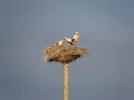Bridget and Peter
Active Member
- Time of past OR future Camino
- Home to Reims 2007
Reims to Limoges 2008
Camino Ingles 2009
Limoges to Gernica 2009
Gernica to San Vicente de la Barquera 2010
San Vicente to La Isla 2012
La Isla to Santiago Sept/Oct 2014
Just had a thought - are we likely to see storks nesting along the del Norte in April? I've always wanted to!
Bridget
Bridget




















